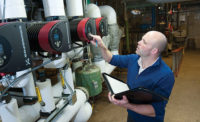Irr Supply helps provide pump solution for historical landmark








In 1856, Franz “Rudolph” Wurlitzer emigrated from Europe to Cincinnati and established the Rudolph Wurlitzer Co., as a reseller of various types of organs — hurdy-gurdies, barrel organs and the like — made by the deKleist Musical Instrument Mfg. Co., located in North Tonawanda in upstate New York.
A half century after the company’s startup, Wurlitzer’s son, Howard, purchased Eugene deKleist’s company and the newly renamed Rudolph Wurlitzer Mfg. Co. soon became known for creating the “best musical instruments in the world.”
Following the 1908 acquisition, Wurlitzer moved one of its three busy manufacturing facilities into deKleist’s old building in North Tonawanda and immediately began enlarging operations. With expansion and the addition of a giant Wurlitzer sign, the building became the company’s main manufacturing plant and a beloved symbol of local enterprise. Until it closed in 1975, the building manufactured varied musical instruments, including the “Mighty Wurlitzer Theater Organ,” as well as phonographs, jukeboxes and keyboards.
The structure was expanded several times in the early 1900s, eventually encompassing an area of roughly 750,000 sq. ft., including a three-story building and a single-story facility. “In its heyday, 3,000 people worked there,” says current owner Tom Austen, who lives in Tonawanda and has owned part of the building with his wife since 1992.
However, by the mid-1970s the venerable building “was on the docket to get demolished,” says Austen, who recently recalled for The Tonawanda News that “no one was in it for a couple years and water was coming through the roof. It was desolate and he saved it.”
It was then that a local businessman, plumbing wholesaler Bill Irr Sr., stepped in to plead its case.
“At that time, Bill went to the city insisting it made no sense to tear the building down because it’s an iconic landmark in this area and has such historical significance,” Austen says. “Bill is the one who kept the place from being demolished.”
Irr subsequently purchased the Wurlitzer facility with two others and moved his company — plumbing, HVAC, refrigeration and electrical distributor Irr Supply — into part of the building. In fact, Austen notes Irr Supply (which serves upstate New York and northern Pennsylvania) still uses it as its main distribution center. The company is celebrating its 150th anniversary this year and recently held a major celebration in downtown Buffalo commemorating the elite milestone.
“Bill eventually bought out the other two owners and then sold the three-story part of the complex to my wife and me,” Austen says. Irr Supply remains his tenant in the three-story building with its plumbing showroom and training center. Meanwhile, Irr still owns the majority of the single-story building.
Today, Austen’s property management company, Wurlitzer Industrial Park, is based in the multistory building, which still carries the eponymous sign at its top. Counting employees and tenants, some 400 people use the buildings.
Disruptive change
Two years ago, Austen learned Walmart would be constructing a new facility on a nearby lot. Austen quickly realized his building would be severely impacted by this massive project. He needed to take action prior to construction in order to prepare for disruption of water and sewer lines.
“The new building was to be a major construction project situated very close to our complex,” he explains. “The retailer would be creating parking lots and moving sewer and water lines. That meant we had to abandon our own sewer line and come up with an effective alternative.”
Wurlitzer building facilities manager Mark Berube began the research. “The bathrooms for both buildings are all connected and tied together in the basement of the one-story building,” he explains. “In order to abandon that sanitary line and put in new, ordinary plumbing for both buildings, we would have had to make floor cuts through the concrete. But our building cement is so solid and is really a chore to get out. I started doing the cost estimate for new plumbing and stopped at $25,000.”
Austen agreed with Berube that such an expense wasn’t justified. Additionally, they were concerned about the impact a conventional plumbing renovation would have on their tenant.
“Irr Supply’s shipping dock doors are right where we would have had to cut across and into the cement,” Berube explains. “They would have had to shut down their docks and work people at all kinds of weird hours. I don’t know how they would have shipped stuff out.”
It’s always complicated and challenging to bust through concrete, but — as Berube has already mentioned — the Wurlitzer building had a greater challenge than usual.
“The cement under our building is one of the hardest in the country,” Austen says. “In the early 1900s when they were adding on to this complex they used rock from the river across the street to form the aggregate. A few years ago, we had some work done by a contractor who cut into the cement and he showed us a special map that indicated how hard our cement is.”
Irr delivers a better solution
Clearly, conventional plumbing would be difficult, time-consuming and very costly, and Austen’s tenant, Irr Supply, would have suffered an expensive disruption of business if it had gone that route. So Berube set about finding a better solution. “I figured, why not ask Don Smith at Irr Supply?” he says.
“When Tom and Mark advised me of their project, the first thought was to design the project around a traditional duplex sewage system with basin, pumps and alarms,” says Smith, vice president of purchasing at Irr. “But the cost of the labor to install was overwhelming.”
So Smith helped Berube come up with a smarter plan that was better for both tenant and owner. In fact, Smith was not only able to recommend the right product for this challenge; he also was able to supply it. A distributor for SFA Saniflo, Irr Supply specified a Sanicubic 2 heavy-duty duplex grinder pump.
Well-suited for commercial applications, the pump contains a pair of 1-hp motors that adeptly handle sewage and wastewater from several fixtures. The units, which pump up to 50 gallons per minute, are designed to operate individually and alternately to avoid overuse. This was an important feature for Berube, who needed to ensure the new plumbing system – which handles 11 toilets, six urinals and six sinks – would remain operable even if one unit went out.
“I really would not have felt comfortable with just a one-pump system,” he says. “I told Don we needed something that is going to take care of all our needs and had a backup in case something went wrong.”
Because it sits on the floor, the unit eliminates time-consuming and costly drilling through concrete. To maximize longevity while minimizing maintenance, the unit houses comparatively few components: the duplex pumps, stainless-steel cutting blades, two pressure switches and a circuit- board assembly that starts and stops the unit. A common spindle shaft operates the impellers and the cutting blades.
“Kudos to Don Smith,” Austen says. “He educated us on what would be the best product for the project. It was his idea to go with this unit and he saved us a lot of time, effort and money.”
Lockport, N.Y.-based RIC Plumbing installed the system in the basement of the one-story section of the Wurlitzer building. The installation took only one day.
“The pump is well-suited for the application,” RIC Plumbing Mechanic Scott Kuhns says. “The building is very old. Digging would have been very difficult.”
Counting materials and labor, Austen estimates the total cost installed was around $6,500. “It was so much more affordable than our original projection of $25,000-plus,” he says. “Plus, Irr Supply wasn’t disrupted. In one day they were back in business. I think we’ve had to hit the reset button on it once or twice. We haven’t done any maintenance. It’s been a working champ and fits the application perfectly.”
Author bio: Julie Reynolds is a longtime industry freelance writer. She can be reached at jrcommunications@comcast.net.
HELPFUL LINKS:
Looking for a reprint of this article?
From high-res PDFs to custom plaques, order your copy today!









